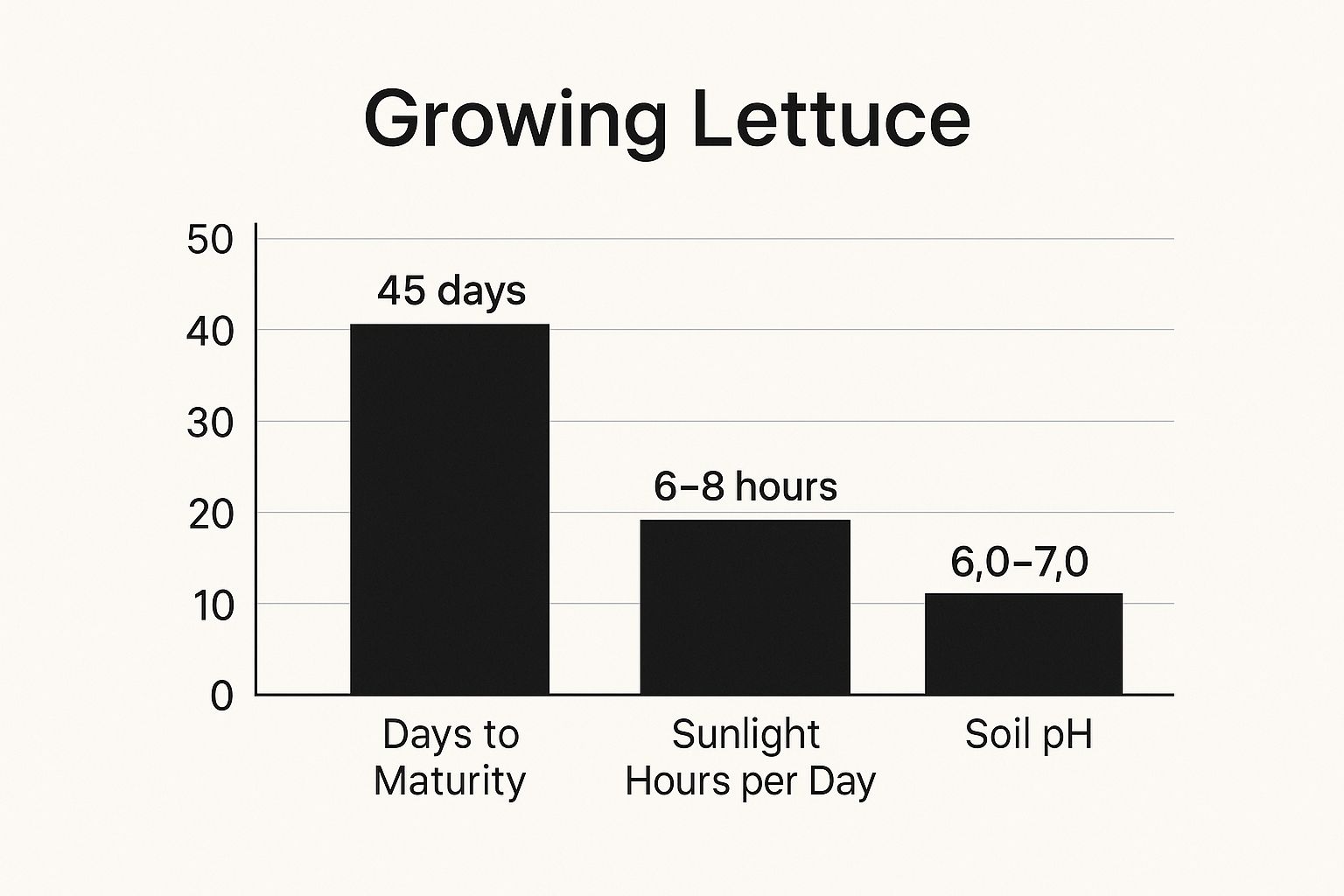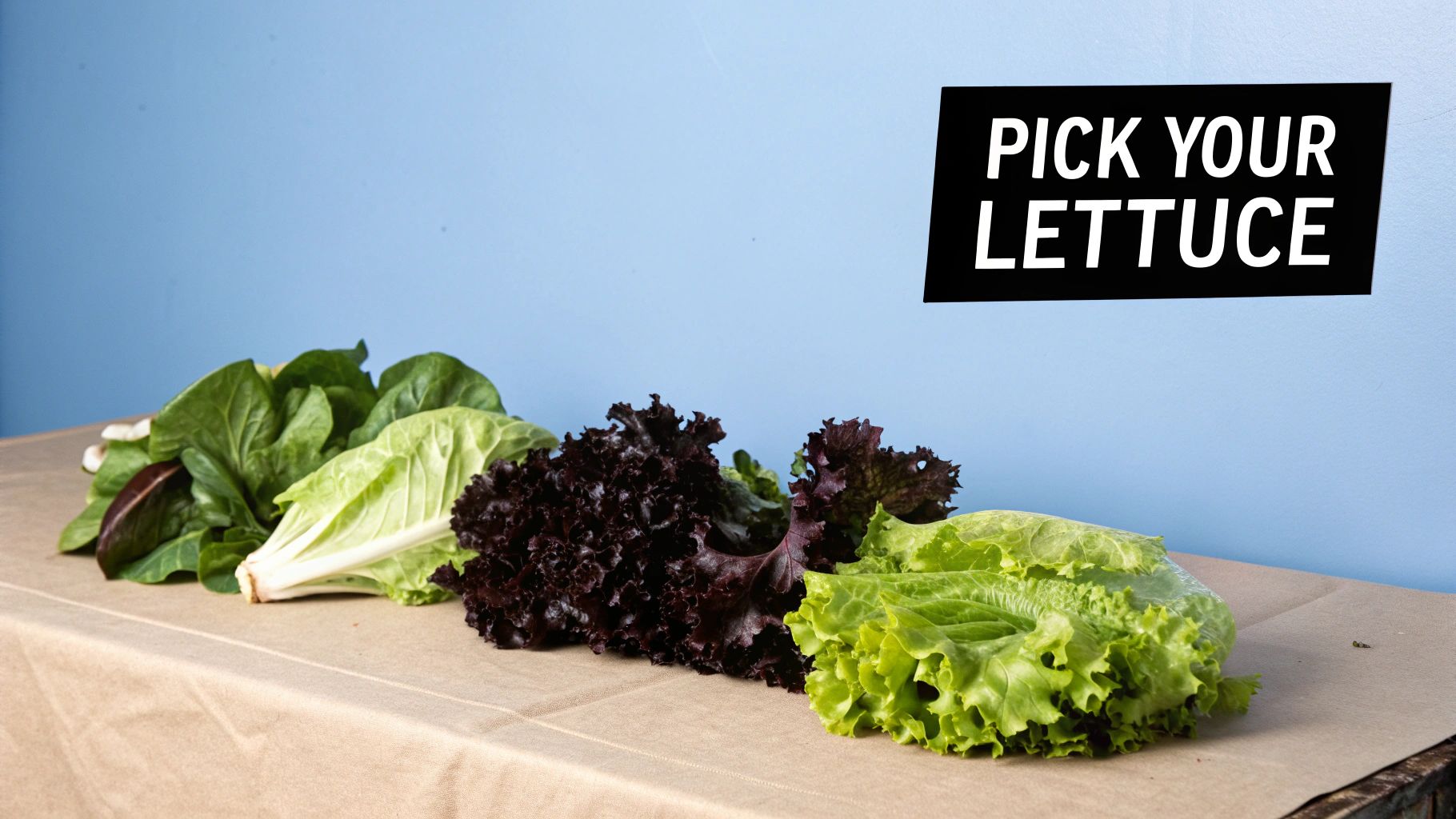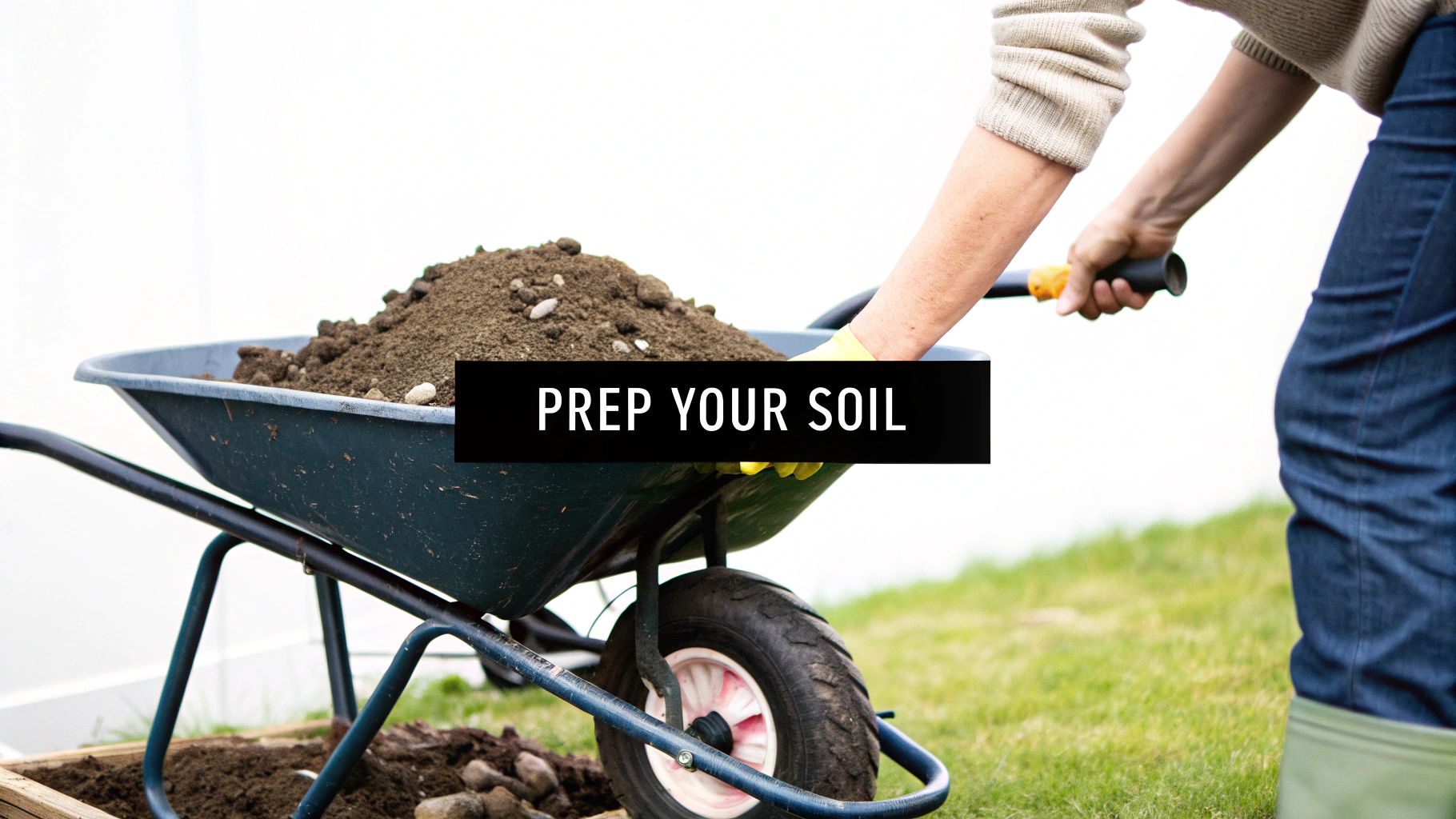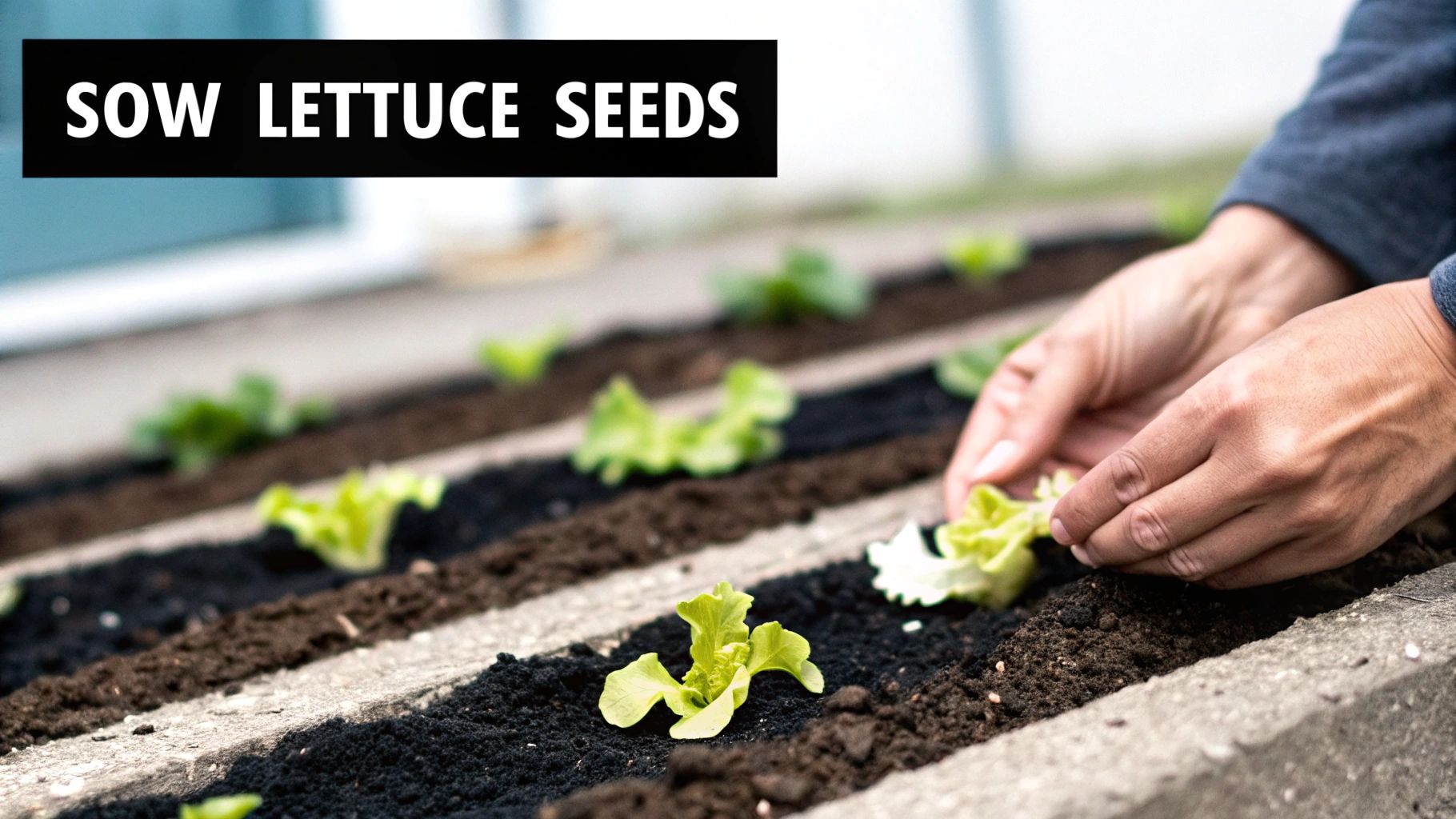
How to Grow Lettuce: Your Complete Gardening Guide
How to Grow Lettuce: Your Complete Gardening Guide
To get lettuce right, you have to start with the right seed. Growing a successful crop is all about matching the plant to your specific climate and garden space. Forget what you see at the grocery store for a minute—the world of lettuce is surprisingly diverse.
The four main families you'll encounter are Crisphead, Romaine, Butterhead, and Loose-Leaf. Each one brings something different to the table, both in flavor and in how they grow. Some are built for cool spring weather, while others can take a little summer heat without bolting.
Choosing the Best Lettuce for Your Garden
Picking the right lettuce isn't just a preference—it's the first real step toward a great harvest. Different types have completely different needs, so you have to know what you're working with.
Crisphead varieties, like the classic Iceberg, demand a long, cool growing season to form those dense, tight heads. They're a bit fussy. On the other end of the spectrum, you have Loose-Leaf types like 'Black Seed Simpson' or 'Oakleaf'. They mature fast and are way more forgiving if a warm spell hits.
Romaine and Butterhead lettuces are the happy middle ground. Romaine gives you that sturdy, crisp texture, while Butterhead varieties like 'Boston' or 'Bibb' are famous for their soft, almost velvety leaves. Your local climate is the deciding factor here. If you're gardening up north, you might have great luck with Crispheads. Down south? You’ll want to stick with heat-tolerant loose-leaf or romaine varieties.
This quick visual breaks down the core needs for growing almost any type of lettuce.

Keep these numbers in mind—maturity time, sunlight, and soil pH. They're the foundation of a healthy lettuce patch.
Understanding Lettuce Families
Choosing a lettuce family is like choosing a path. It determines when you plant, how you harvest, and what ends up on your plate.
Here’s a quick-glance table to help you compare the main types. It covers how they grow, how they handle heat, and where they shine in the kitchen.
Comparing Popular Lettuce Varieties

As you can see, there's a perfect lettuce for just about any garden or meal plan. Your best bet is to plant a few different kinds to see what performs best for you.
Loose-Leaf: This is the easiest place to start, hands down. You can snip off the outer leaves as you need them, and the plant just keeps growing from the center. It’s the gift that keeps on giving.
Romaine: Known for its tall, upright growth and crunchy ribs. It’s generally a bit more heat-tolerant than the heading types, making it a reliable choice for many gardeners.
Butterhead: These form beautiful, loose heads of tender leaves. They have a delicate, buttery flavor and are a favorite for high-end salads.
Crisphead: The most challenging of the bunch. It needs consistently cool weather to mature properly, but the reward is that unmistakable crisp, crunchy texture.
The demand for fresh, interesting greens isn't just in our backyards; it's a global trend. The worldwide lettuce market hit $4.13 billion in 2024 and is projected to reach $5.54 billion by 2031, largely because more people are seeking out healthy, low-calorie foods. While Iceberg and Romaine still dominate, unique varieties like Butterhead are gaining ground fast. You can dive deeper into the global lettuce market trends over at Precision Business Insights.
Get the Ground Ready for a Thriving Lettuce Patch

Great lettuce starts with great soil. There's just no way around it. Those tender, crisp leaves are mostly water, and they need a foundation that can hold moisture without turning into a bog. I always tell new gardeners to think of their soil like a sponge, not a brick—it should be loose, rich, and full of life.
Whether you’re working with raised beds, containers, or a traditional in-ground row, the goal is the same. You're aiming for that perfect loamy texture that's both well-draining yet moisture-retentive. Heavy clay soil is a recipe for root rot, while sandy soil drains so fast your lettuce will constantly be begging for a drink.
The easiest way to get that balance is by working in plenty of organic matter. A few inches of well-rotted compost or aged manure mixed into the top 6-8 inches of your soil can completely change the game. It improves the soil's structure and gives your plants a slow, steady supply of nutrients. If you want to go deeper, check out our guide on finding the best soil for growing vegetables.
Fine-Tuning Your Soil and Planting Plan
Beyond just getting the texture right, lettuce really does best in a slightly acidic to neutral soil pH, somewhere between 6.0 and 7.0. Hitting this range is important because it unlocks the key nutrients in the soil, making them available for the plant's roots. A simple soil test kit from any garden center will give you a quick reading and let you know if you need to make any tweaks.
Once your soil is ready, it's time to decide how you'll get your seeds in the ground. You’ve got two main paths:
Starting Seeds Indoors: This gives you a 3-4 week head start on the season, which is a big deal in cooler climates. Just plant your seeds in trays and move the seedlings out to the garden once they have a few true leaves.
Direct Sowing: This is the simpler route. You just sow the seeds directly into your prepared garden bed. It’s less fuss, but you'll be waiting a bit longer for that first salad.
A classic mistake I see all the time is planting lettuce seeds too deep. These seeds are tiny and actually need light to germinate. Barely cover them with about 1/8 inch of fine soil, and that's it.
This push for better seeds isn't just a backyard thing. The global lettuce seed market was valued at around $500 million in 2025, a number driven by breeders developing varieties with better disease resistance and bigger yields. You can find more industry insights over at marketreportanalytics.com.
Your Lettuce Care and Nurturing Routine

Once your lettuce seeds are in the ground, your job shifts from planter to caretaker. This is the part that turns tiny sprouts into crisp, sweet heads of lettuce, and it isn't complicated. It all comes down to three things: water, sun, and food.
Lettuce leaves are about 95% water, which tells you just about everything you need to know. Your goal is to keep the soil consistently moist—think of a well-wrung sponge, not a muddy bog. If the soil dries out completely, the plant gets stressed and the leaves turn bitter. On the flip side, too much water can lead to root rot.
For a deeper dive into getting the moisture just right, our guide on how often you should water plants has some great insights that apply perfectly to your lettuce patch. Generally, giving your bed a good, deep soaking two or three times a week is far better than a light sprinkle every day.
Sunlight and Feeding for Lush Growth
Lettuce grows best in what I call the "Goldilocks zone" of sunlight. It needs about six hours of direct sun a day to thrive, but it can't stand being scorched by intense heat. Morning sun is ideal because it fuels growth without the stress of the peak afternoon sun.
In warmer climates, one of the best things you can do for your lettuce is give it some afternoon shade. A taller plant like a tomato can do the job, or you can use a bit of shade cloth. This simple step keeps the leaves from wilting and prevents the plant from bolting (flowering) too early.
When it comes to feeding, lettuce is a pretty light eater. Since you're growing it for its leaves, a fertilizer rich in nitrogen is its best friend. Nitrogen is what fuels that vigorous, leafy green growth we're all after.
You don't need to fertilize often. A light feeding with a balanced, water-soluble fertilizer or a dose of compost tea about three weeks after the seedlings pop up is usually all it takes. That little boost will encourage tender, flavorful leaves and set you up for a fantastic harvest.
Dealing With Common Lettuce Problems

Even with the best soil and a perfect watering schedule, every gardener runs into a few snags. Think of this as your field guide to troubleshooting the little things before they become big headaches, keeping your lettuce patch healthy and productive.
Pests are often the first challenge. Slugs and aphids, in particular, find tender lettuce leaves just as tasty as we do. Slugs are notorious for their nighttime raids, leaving behind ragged holes and shiny slime trails. Aphids are much smaller, gathering in colonies on the undersides of leaves where they suck the life out of the plant.
For aphids, there are simple, effective fixes. For more in-depth strategies, mastering organic aphid control is a great resource. Often, a strong jet of water is enough to knock them off, and welcoming beneficial insects like ladybugs into your garden provides a natural, long-term defense.
Tackling Environmental Stress
Beyond pests, lettuce is sensitive to its environment. The two most common issues you'll face are bolting and bitter leaves, and they usually go hand-in-hand. Bolting is just a fancy term for when the plant sends up a flower stalk and tries to set seed, which puts an end to your harvest.
This is almost always a reaction to heat stress. Once temperatures start to consistently climb above 75°F (24°C), many lettuce varieties take it as their cue to bolt.
The minute you spot that central stalk shooting up, the clock is ticking. The leaves will quickly turn bitter as the plant redirects all its energy from tasty leaf production to making seeds. It's a natural survival instinct.
You can outsmart bolting with a few simple tricks:
Provide Afternoon Shade: A bit of shade during the hottest part of the day makes a huge difference. You can use taller plants like tomatoes or a simple shade cloth to give your lettuce a break.
Keep the Soil Moist: Dry soil is a major stressor. Maintaining consistent moisture helps keep the plants cool and happy.
Pick the Right Varieties: If you're planting for late spring or early summer, look for cultivars specifically labeled as "bolt-resistant" or "slow to bolt."
Another issue, especially in cool, damp weather, is downy mildew. It shows up as yellow spots on the tops of leaves with a fuzzy grey mold on the undersides. Good air circulation is your best defense here. Make sure you give your plants enough space when you plant them and always water the soil at the base, not the leaves.
A little vigilance goes a long way. By keeping an eye out for these common problems, you can solve them quickly and keep the fresh salads coming all season.
How to Harvest and Store Your Lettuce
This is the moment all your work pays off—when you finally get to bring those crisp, homegrown greens into your kitchen. The secret to the best-tasting lettuce is knowing just when to cut it and how to handle it afterward. Your approach will change depending on what you’ve got growing in your garden beds.
If you planted loose-leaf varieties, you’re in luck. You get to use the "cut-and-come-again" method, which is a game-changer for extending your harvest. Instead of pulling up the entire plant, just snip off the outer leaves about an inch from the soil. This keeps the heart of the plant intact, allowing it to push out new growth for weeks to come. It’s like having a living salad bowl right outside your door.
For head lettuces like Romaine or Butterhead, it's more of a one-and-done deal. You’ll want to wait until the head feels full and firm. When it’s ready, take a sharp knife and slice the whole plant off right at the soil line. It’s a clean, single harvest.
Timing and Storing Your Harvest
The absolute best time to pick any lettuce is in the cool of the morning. The leaves are at their crispest then, full of moisture from the cool night air. Harvesting them at this peak time helps them stay fresh much longer once they're in your fridge.
Once you’ve brought your greens inside, storing them properly is everything. My go-to method is to give the leaves a good wash in cold water and then spin them completely dry in a salad spinner. From there, I pack them into a container or a plastic bag with a single paper towel tucked inside to soak up any stray moisture.
Properly stored, homegrown lettuce can easily stay crisp in your refrigerator for 7-10 days. That's a huge improvement over most store-bought greens that seem to wilt in a day or two. That paper towel trick is the key—it’s what stops the leaves from getting slimy.
Keeping your produce fresh is a huge win for any home gardener. If you're looking for more ideas, our guide on preserving food at home has some great techniques. You can also explore ways to preserve fresh produce for the long term. While a dehydrator won’t work for delicate lettuce, it’s a fantastic tool for many other things you’ll pull from the garden.
It's also interesting to see the bigger picture of where our food comes from. For instance, while domestic lettuce production in the U.S. recently saw a 6% decline, export volumes actually went up. It’s a reminder of the complex journey food takes. You can discover more insights about these market shifts on the USDA's website.
Got Questions About Growing Lettuce?
Even after years in the garden, questions pop up. Lettuce can be finicky, but most problems have simple fixes. Here are some of the most common issues I see and how to handle them.
How Often Should I Water My Lettuce?
Lettuce is thirsty, but it hates wet feet. The goal is consistent moisture. I aim to water deeply two to three times per week, but I let the soil tell me what it needs. If it’s hot and dry, that might mean watering more often.
The easiest trick? Stick your finger an inch into the soil. If it’s dry, it’s time to water. I’m a big fan of drip irrigation for lettuce—it sends water right to the roots and keeps the leaves dry, which is a huge help in preventing fungal diseases.
Why Does My Lettuce Taste Bitter?
Bitter lettuce is stressed lettuce. Simple as that. The number one cause is heat, followed closely by inconsistent watering. When the plant gets stressed, it produces compounds that ruin the flavor and signal that it's about to bolt (go to seed).
To keep your lettuce sweet, give it some afternoon shade, especially if you live in a warmer climate. And here's a pro tip: always harvest in the cool morning air. The leaves are fully hydrated and at their peak flavor. It makes a world of difference.
Can I Successfully Grow Lettuce in Containers?
Absolutely! Lettuce, especially the loose-leaf types, is perfect for container gardening. It’s a great way to get a fresh harvest right on your patio or balcony.
A few things to keep in mind:
Pot Size: Don’t skimp on space. Choose a pot that’s at least 6-8 inches deep with good drainage holes.
The Right Soil: Garden soil is too heavy for pots. Use a quality potting mix that will stay fluffy and drain well.
Watering: Containers dry out fast. On warm days, you’ll probably need to check the soil and water daily.
At The Grounded Homestead, our goal is to help you grow with confidence. For more real-world gardening tips and homesteading advice, explore our other resources at https://thegroundedhomestead.com.


Facebook
Instagram
X
Youtube